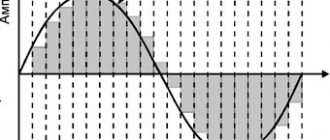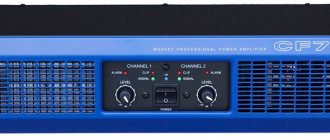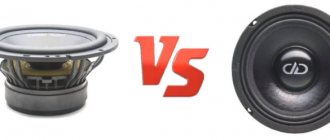Good afternoon, dear readers of my blog! If we already know each other, then you know that I am a sociable and sympathetic person, I have many acquaintances, relatives and friends with whom I often spend time and help them in choosing equipment. Usually in everyday life my knowledge is required spontaneously.
For example, not long ago I met a classmate whom I had not seen for several years. He invited me to his dacha, where his parents live. While having a pleasant tea, the elderly people remembered that somewhere they had a disk with a recording of our school concert. I was happy to feel nostalgic about my former youth, but it didn’t work out - the device was either demagnetized or glitched, and I couldn’t play the video. As it turned out, none of those present knew about blu ray - I’ll tell you what it is in more detail now, but this particular format could help save valuable memories.
What is it and what is it eaten with?
The advent of DVDs marked a new era in digital technology. VHS film cassettes have been replaced by compact, reliable round media. And the consumer was immediately notified that the format war was over. But that was not the case, progress does not stand still and now we are offered a new high-tech device.
So, what is blu ray? In simple layman's terms, it is an optical medium on which information is written using a blue (blue-violet) ray, as opposed to infrared in the case of DVD.
The name comes from the English phrase blue ray - blue/blue ray. But since this phrase is often used in everyday life, it could not be patented and turned into a brand, as something not unique. In order to have copyright on this development, the inventors of the new format took away the last letter from the word “blue”, creating a new trademark “blue ray disc”.
The first prototypes of such a medium appeared relatively recently, at the end of the last century - more precisely, in October 2000 - and entered the market a little more than 10 years ago, in 2006, competing with the HD DVD format.
Modern Blue-ray formats
The cheapest option is the read-only Blue-ray ROM standard. The second option - BD-R (Blue-ray recordable) can be used for recording only once. This is the most popular product for recordable players. The main purpose of such disks is to preserve and distribute information.
BD-R can be single- or double-layer: production is based on sputtering technology, just like RW discs. The pinnacle of blue ray technology is the BD-RE (Blue-ray Writable) series discs, which can withstand up to 1000 rewrites. These disks use working layers that change their phases. Such material has proven itself well in the creation of DVD-RW and CD-RW: given the new technology, all that remains is to adjust the system to the new blue wavelength. BD-RE storage media, due to the possibility of repeated rewriting, are an economically advantageous purchase.
Obviously, Blue-ray cannot be played on a player designed for viewing (listening) to files on CD or DVD media. Therefore, today manufacturers offer universal systems that can accept both regular CDs and those created using Blue-ray technology.
Some scientific statistics
The easiest way to explain to the average person what the Blu-ray format is is by comparing it with DVD discs.
- The first thing that comes to mind is that blu ray is more spacious. If a single-layer DVD recorded using a red ray can store about 5 GB in its memory, then a Blu-ray with the same diameter can store five times more.
- Both formats come in the same size – 120 mm. But using a shorter blue beam helps compress the track pitch from 0.74 µm to 0.32 µm, packing more information into the same area.
- Given the same thickness of DVD and Blu-Ray discs, the protective layer of the latter is 0.5 mm thinner.
- Blu-ray has a hard Durabis coating, DVD does not. This protective layer protects the surface of discs from scratches, making them insensitive even to dry paper napkins, while they can irreparably damage DVD format media.
- Blu Ray format is capable of transferring data (for example, text files, photos) at speeds of up to 36 Megabits per second, while DVD cannot exceed the traffic limit of 11 Mbits/s. What can we say about video and audio downloaded to a Blu-ray disc at 54 Mbit/s.
- Consumers, when asking what blu ray quality is, don’t really delve into it and think that it’s just a disc with more memory. There would be no great discovery in this if the advantage was only in capacity. In fact, blue ray is a fundamentally new video quality. It is not without reason that many Hollywood film companies - Worner Bros. set an example - have abandoned other formats and are releasing their films exclusively on blu ray. You don’t need to be a professional to understand that a resolution of 1920x1080 and a bitrate - the degree of compression of the stream - 40 Mbit/s are much more functional than 720/480 and 9.8 Mbit/s, respectively. The last indicator is especially important, since the higher the bitrate, the better the picture.
Naturally, I did not present all this information in detail either to my classmate, or, especially, to his parents. Even I, a person who communicates with technology every day, cannot understand all the intricacies of the format. What is needed here is a professional with a narrower profile and a higher level. Ordinary consumers - in the best sense of the word - need to understand only two things: Blu-ray is high quality video and larger data storage than classic DVD discs.
How are LCD TV displays different?
First is the resolution. Resolution is the size of the display, measured in pixels. The higher the resolution, the clearer the picture you will get.
Secondly, the size of the point. The smaller the screen dot on your device, the better the image quality. But, accordingly, the smaller the screen will be.
It is quite important to look at the proportional format. This indicator is defined as the ratio of width to height. Our TV broadcasting is carried out in 4:3 format. But it’s better not to choose such a TV, since all films today are shot primarily in 16:9 format. And very soon Russian TV will switch to widescreen broadcasting.
One of the important indicators is the diagonal. Screen diagonal is most often measured in inches. Let us remind you: 1 inch corresponds to 2.5 cm.
Also important indicators are contrast (that is, the ratio of brightness, which is taken from the brightest point to the darkest), brightness, and viewing angle. The last indicator for a TV is quite important, since watching TV rarely occurs from one point. The higher the viewing angle, the better.
Competition with HD DVD
I hope I have clearly explained to you what blu ray is and how this format differs from previous generation media, which use red and infrared (CD discs) rays for recording. However, HD DVD discs competed with it for quite a long time; even Warner Brothers switched to Blu-ray only in 2008, and then, partly in order to stop the format war.
What are the similarities and differences between these types of media?
| Similarities | Differences |
| To record information on Blu-ray and HD DVD, they use the same short blue rays with a length of 450 nm. | The capacity of blu ray format is on average 1.5 times larger. |
| The standard disc diameter is 120 millimeters. | Unlike HD DVD, Blu-ray is not compatible with DVD. Thus, we can say that HD DVD is a buffer between old and fundamentally new digital technologies. |
| Both formats come in single-layer and double-layer. | The HD DVD format is produced on the basis of old optical media, and therefore does not have the Durabis protective coating. |
| Both formats use the same compression methods MPEG-2, Video Codec 1 and H.264. | Blu-ray technologies are constantly being developed and now Pioneer produces 3- and 4-layer discs. Also, 9 years ago this same developer presented 16- and 20-layer media with a capacity of 400 and 500 GB, respectively, but so far this format is not on sale. |
In principle, both formats are capable of providing high quality audio and video playback. But personally, I would note the longer service life of Blu-ray media, if only because of the hard protective coating. The advantage of HD DVD is that its playback does not require the invention of new types of players - due to the same “blanks”, old DVD players can be converted to this format. True, such a technology cannot produce the quality of 4k digital cinema, which Hollywood film studios have already appreciated.
The cream of Blu-ray. Group test of Blu-ray players
Music also sounds good, although along with the balance of high frequencies, high resolution of details and powerful drive, it is worth noting a certain lack of mobility, especially noticeable in complex rhythmic structures. Given the company's enviable reputation in digital music, the lack of streaming online content seems surprising.
Add to this the remote control, which requires rework, and the tendency to freeze on some discs, and the lower rating of the 651BD seems quite logical - its rivals are slightly stronger in the test.
TIP OF THE DAY
If you want to connect two displays to the Azur 651BD, remember that HDMI 1 output provides the best quality for DVD upscaling.
PROS: High quality picture and sound; equipment, including two HDMI outputs
CONS: Few online services; inconvenient remote control; competitors are
VERDICT: Very good in many ways; serious threat to rivals in its class
Technique
- Outputs: 2 HDMI, component and composite video, optical digital, coaxial digital, 7.1 channel analog
- Inputs:Ethernet, 2 USB, e-Sata
- Dimensions (H×W×D):8×43×31 cm
- Weight:5kg
Denon DBP-2012UD
This player captivated us when it first appeared and cost 40,000 rubles. so much so that he was awarded the award in 2011.
Now it has become more accessible, and its appeal has grown even more. The elegant, if somewhat conservative, style of the DBP-2012UD, as well as the quality of its construction, can serve as a decoration for this price category.
The list of connections is quite extensive, but it is missing something. On the one hand, Denon has an eight-channel set of analog outputs, including for rear speakers in a 7.1-channel system, so it can be easily integrated into an existing DC. There is also a separate set of analog outputs for connecting to a stereo system. On the other hand, neither Denon nor Marantz from the next page have a second HDMI output, unlike the other models in the test. For owners of outdated AV receivers, this factor may be decisive.
And this is a shame, because the talents of DBP-2012UD are truly boundless. "Captain America: The First Avenger" on 3D Blu-ray disc delights with the stability of the image and the confident transfer of dizzying cinematic effects. "Spy, get out!" in 2D it is no less good: one cannot help but notice the enviable depth and amazing meticulousness in the elaboration of textures and flesh tones.
Owners of DVD collections will be pleased with the scaling quality of the Anchor Bay ABT2015 processor; The picture in the movie “Super 8” is amazingly good. The dark background in the famous train crash scene shows density and lack of noise; Contours remain clear and stable even when moving quickly.
And the most impressive thing about the Star Trek movie is the sound quality. The Blu-ray disc's audio track and the DBP-2012UD's transport quality deliver a truly cinematic-scale performance, combining monstrous dynamics and a spacious sound field with rich textures. No budget player will give you such immersive sound.
Denon is equally good at music. Burr-Brown DACs (32 bit/192 kHz) know their stuff; and although the sound lacks a little articulation, and the bass is somewhat warmer than we would like, the rhythm of the DBP-2012UD is excellent. Its inherent transparency lends itself well to albums like Eric Bibb's Good Stuff on SACD
Denon's list of streaming options isn't too extensive; it has YouTube, but not services like Netflix, although the American version of the same model does have them. In addition, the DBP-2012UD does not support FLAC music files.
Overall, there's quite a list of complaints, but Denon's talents outweigh any shortcomings, especially considering the new price. This Blu-ray player is exceptionally good.
BEFORE THE PURCHASE
If you dream of 3D, you will have to get an AV receiver with support for 3D video: the Denon player has only one HDMI output
PROS: Magnificent picture in all respects; excellent sound; quality of construction
CONS: Only one HDMI output; too few streaming services
VERDICT: A brilliant turntable, previously awarded at RUB 40,000. has now become completely irresistible
Technique
- Denon DBP-2012UD
- Outputs: 1 HDMI, component and composite video, coaxial digital, 7.1 channel analog, stereo analog
- Inputs: Ethernet, USB
- Dimensions (H×W×D):11×43×32 cm
- Weight:5.2kg
Marantz UD7006
The Denon DBP-2012UD sets the bar high, but the Marantz UD7006 is just as impressive; This is not surprising, given the almost complete identity of these models.
The layout of some controls has been slightly changed for the sake of stylistic unity with other Marantz components, but the “filling” is the same - the Anchor Bay scaling processor, Analog Devices video DAC, Burr-Brown audio DAC and main connectors.
Due to these similarities, the UD7006 has the same advantages and the same minor disadvantages as its counterpart. It is equipped with analog outputs, which will allow it to be integrated into an outdated home theater and into a Hi-Fi system, but it only has one HDMI output. For potential buyers with older AV receivers, this will be a major problem when playing 3D. For those who aren't particularly interested in 3D, there's nothing to worry about.
In other respects, there are practically no complaints about Marantz. Blu-ray playback is predictably great, especially if the 2D transfer is good, like in True Grit. Epic landscapes are painted with bright and bold strokes; the detailed and silent backgrounds, the amazingly clear details, and the majestic camera pans are very convincing.
Like the Denon, the Marantz is particularly good at upscaling DVDs to the 1080p standard. The movie "Cars 2" has dense and silent backgrounds, flawless large colorful objects, excellent motion transfer and clear contours. This will please owners of large DVD collections.
Marantz sounds just as great. The Ramones' swashbuckling "Sheena Is A Punk Rocker" exudes enthusiasm, and the punchy bass guitar demonstrates greater stereo prowess than rival Denon's.
When playing multi-channel music discs, the difference is less noticeable, and the sound of movies, especially when playing via HDMI, is practically indistinguishable between these two models. As we noted in our Denon review, detail, scale and drive are far superior to budget turntables; the same can be said about the UD7006 - although it cannot be denied that the lion's share of responsibility for the quality of performance falls on the AV receiver.
In terms of streaming, Marantz's position isn't too strong; There aren't many online services, and it doesn't support FLAC, although high-quality AAC and WAV formats sound pretty good.
The UD7006 is still damn attractive, even with the price increase. Still, unless slightly better CD quality is a deal-breaker for you, the Marantz doesn't have much of a chance of justifying the higher price tag over a nearly identical Denon player.
TIP OF THE DAY
If you decide to listen to a CD, try connecting the Marantz to the system via the analog outputs; The sound may be better than digital
PROS: Excellent picture; excellent sound, especially in music; luxurious design and appearance
CONS: One HDMI output; few streaming services; very similar to Denon, only more expensive
VERDICT: Very good, especially for music lovers, but seems overpriced
.
Technique:
- Outputs: 1 HDMI, component and composite video, coaxial digital, 7.1 channel analog, stereo analog
- Inputs: Ethernet, USB
- Dimensions (H×W×D):11×44×33 cm
- Weight: 5.1 kg
Onkyo BD-SP809
The Onkyo player has two major differences from other test models: the lack of DVD-Audio and SACD playback and the presence of THX certification. The company's reputation in this market sector can be the envy of many; The BD-SP809 is clearly aimed at the legion of loyal owners of Onkyo AV receivers.
The set of connectors reflects the specific range of requests of this target audience. Unlike its competitors, Onkyo doesn't have multi-channel audio output; There are only a couple of sockets for connecting to a Hi-Fi system. But it has two HDMI outputs; They can be used to transmit video and audio signals separately, or they can send video and audio simultaneously over two channels. However, only the “main” HDMI output provides optimal picture quality with THX certification.
The workmanship meets the high standards of the price class. The independent design of the analog and digital circuits helps reduce electromagnetic interference, while elements that create mechanical vibration, such as the motor block, are directly “tied” to the rigid frame.
The simplified remote control and small and not very informative display of the BD-SP809 did not particularly impress us.
But all these earthly matters pale in comparison to the amazing work of Onkyo. The 2D image quality is excellent; Contagion's impeccable transfer benefits even more from its brilliant reproduction. Dense, vibrant colors and fluid movement are combined with high detail and stunning clarity. Movies in 3D are just as good; “Avatar” delights with its multi-layeredness and unshakable stability of the image.
Thanks to the Marvell QDEO upscaling processor, the BD-SP809's DVD playback quality is almost as good as that of Denon and Marantz models. Colors and contrasts are slightly less vibrant, but the clear picture suffers little from noise or edge jitter.
The Onkyo's sound is also quite impressive. It is especially good when playing Blu-ray discs; its energy reinforces the scale and spaciousness of our reference system's sound.
Stereo sound is also quite good - this is quite unexpected, given the obvious focus of the BD-SP809 on multi-channel tracks. It's not as expressive as the Marantz, but the CDs exhibit great refinement and adequate rhythmicity. The quality of streaming playback is not satisfactory, unlike its range: you cannot listen to files in FLAC and WAV formats over the network, and there is no support for MKV video.
For those looking for the perfect home theater experience, Onkyo is the perfect choice. However, he lacks the versatility to win today's Test.
BEFORE THE PURCHASE
Onkyo doesn't play DVD-Audio or SACD, and doesn't have multichannel outputs; it is intended for owners of branded receivers.
PROS: Top-notch Blu-ray picture; scaling; luxurious and powerful sound in films; not bad in stereo
CONS: Weak broadcast support; no multi-channel audio output
VERDICT: Great choice for DK fans, but lacks versatility
Technique:
- Outputs: 2 HDMI, component and composite video, optical digital, coaxial digital, stereo analog
- Inputs: Ethernet, USB
- Dimensions (H×W×D):10×43×31 cm
- Weight:4.7 kg
Oppo BDP-93
Oppo may be less known to the average consumer than Denon, Marantz or Onkyo, but it has quite a fanatical following among home theater enthusiasts, and you'll soon see why. Solid and elegant, the BDP-93U, unlike most of its competitors, is equipped with a well-thought-out and intuitive remote control. This is perhaps the most flexible Blu-ray player in its class, and its equipment outshines any of its competitors in the test.
The first impression is very favorable; The BDP-93 is a universal player that can play DVD-Audio and SACD, as well as HDCD if you have such a rarity. Two HDMI outputs allow you to connect two different displays or a couple of other video and audio devices.
A full set of analog outputs for a 7.1-channel system will allow owners of even old AV receivers to enjoy watching 3D movies.
However, the same can be said about the Cambridge Audio model. The main difference between Oppo and the rest is its support for online media streaming. It allows you to listen to FLAC files with 24-bit/192 kHz sampling, as well as AAC, MP3, Ogg Vorbis, WAV and WMA. As for video, your menu includes AVI, MKV and DivX HD. This will come in handy for many home theater fans; It’s just a shame that at the time of writing this review, Oppo did not support the Netflix online platform.
However, Oppo's Blu-ray playback quality is so amazing that you'll hardly even remember streaming video. The color palette and contrast are excellent; "Spy, get out!" The BDP-93EU's performance delights with its detailed flesh tones and rich textures. The 3D picture is good enough, but not as stable in fast motion as the Denon or Marantz; however, the difference is not too big, and for those who are not attracted to 3D, it will not matter at all. The quality of DVD upscaling, on the contrary, is not satisfactory (thanks to the Marvell QDEO processor): low noise levels, clear details and bold, bright colors.
Why didn't the Oppo player become the winner of the test, having a full set of trump cards in its hands? It's all because of the sound: it's not that bad in itself, it can't stand comparison with its competitors. This is especially noticeable on the analog outputs in stereo. Despite sharing the same Cirrus Logic DACs as Cambridge Audio, the Oppo's sound is much more restrained and cautious than the 651BD. In essence, this is not so bad, and when transmitted via HDMI, the difference is even less noticeable. However, in this case, Oppo's sound is less powerful than that of the test leaders.
However, we were very impressed with the BDP-93EU. It will turn out to be most relevant to the needs of many buyers; he failed to win the test, but this did not make him any less strong.
IDEAL FOR BROADCASTING
When it comes to streaming, Oppo outperforms all its competitors. It supports more formats and has USB and e-SATA inputs
PROS: Great picture; enviable equipment and range of formats; workmanship; remote control
CONS: Not the most exciting sound; 3D instability at times
VERDICT: A stunning player that beats its big-name competitors in many ways
Technique
- Outputs: 2 HDMI, component and composite video, optical digital, coaxial digital, 7.1 channel analog
- Inputs:Ethernet, 2 USB, e-Sata
- Dimensions (H×W×D):8×43×31 cm
- Weight:4.9 kg
Let's sum it up
Winner - Denon DBP-2012UD
There wasn't a single weak link in today's test; however, none of the participants was flawless - each had a couple of flaws. We preferred the Denon turntable's combination of pros and cons
This test was a tough one. It is exceptional both in the impressive strength of its participants and in the difficulty of reaching the final decision.
It's not just the outstanding merits of each player, but also the fact that none of them are perfect in every way. All of them demonstrate higher quality compared to budget models, each of them individually is very good; but if we could combine their best elements in one device, our world would become perfect.
For now, we have to evaluate the small compromises that each model had and their impact on our final decision.
For all the advantages of Cambridge Audio, it is dragged down by three main flaws: insufficient stability in 3D, some control problems and limited streaming playback.
The Denon player would do well to get a second HDMI output and expand its broadcast range; but the quality of its image and sound is above all praise. The Marantz is just as good, and even better in stereo, but exhibits the same limitations in terms of equipment and broadcasting. In addition, it costs 30,000 rubles. more expensive than Denon.
Onkyo is as good as anyone else when it comes to Blu-ray disc playback quality. This is a great player, but Denon's price cut has undermined its position.
Oppo, the most equipped participant in the test, is slightly disappointed by the sound quality and just a little by the stability flaws in 3D. If the company solves these problems, everyone else's position will be at risk.
In the end, we chose the Denon over the more expensive Marantz. Both will delight the owner with excellent picture and sound, which compensates for minor shortcomings. But if Denon had the flexibility of Oppo (or Oppo had the sound quality of Marantz), it would be something truly amazing.
COMPLETE THE SYSTEM
- Projector Panasonic PT-AЕ7000EA, 170,000 —
- AV receiver Pioneer SC-LX85, 90,000 —
- Multi-channel speaker set Monitor Audio Silver RX6 AV12, 129,000 —











